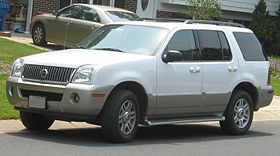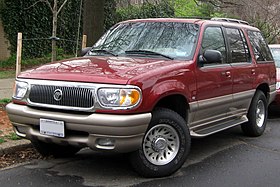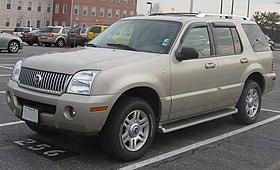Mercury Mountaineer
| Mercury Mountaineer | |
|---|---|
 | |
| Overview | |
| Manufacturer | Mercury (Ford) |
| Production | 1996–2010 |
| Model years | 1997–2010 |
| Assembly | Louisville, Kentucky St. Louis, Missouri |
| Body and chassis | |
| Class | Mid-size SUV |
| Body style | 5-door SUV |
| Layout | Front engine, rear-wheel drive / Four-wheel drive |
| Chronology | |
| Predecessor | Ford Explorer Limited |
| Successor | Lincoln MKT |
The Mercury Mountaineer is a mid-size luxury sport utility vehicle (SUV) that was sold by Mercury from 1996 until 2010. Sharing many of its features with the Ford Explorer, the vehicles were virtually identical in terms of hardware.[1] Externally, they were styled somewhat differently, and the Mountaineer was positioned with a more upscale interior, with the Mountaineer's MSRP coming in at $1,000–$6,000 more than the Explorer.[2] It was last redesigned for the 2006 model year with a new frame, looking very similar to its previous model.
Some controversy resulted after the media highlighted a number of rollovers involving Explorers and Mountaineers fitted with Firestone tires. The Mountaineer has been praised for its excellent handling and stability.[3] The Mountaineer was never sold in Canada.[citation needed] As part of the discontinuation of the Mercury brand, production of the Mountaineer ended in late 2010.[4]
Background[]

In 1990, General Motors introduced the Oldsmobile Bravada sport-utility vehicle, derived from the four-door Chevrolet S-10 Blazer. Though far lower in price, the Bravada was marketed as a competitor to the Range Rover (and the later Land Rover Discovery) and Toyota Land Cruiser. While sharing its body with the Blazer, Oldsmobile differentiated the Bravada with the use of model-specific trim and a dedicated all-wheel drive powertrain (in place of part-time four-wheel drive). For 1993, Jeep briefly revived the long-running Grand Wagoneer nameplate as part of the Jeep Grand Cherokee model line, using woodgrain exterior trim and a leather interior; limited sales led to its cancellation after a single model year.
As a response to the Bravada and the Grand Wagoneer, Ford introduced the 1993 Ford Explorer Limited in 1992. In contrast to the outdoors-themed Explorer Eddie Bauer, the Limited was geared towards on-road driving; it was fitted with all-wheel drive in place of traditional four-wheel drive. The Limited was also distinguished by monochromatic body trim, body-color bumpers, and chrome wheels.
As part of the redesign of the Explorer for 1995, the Limited remained part of the Explorer lineup, with the segment gaining additional competitors through the use of badge engineering. For 1996, the Acura SLX (Isuzu Trooper), Infiniti QX4 (Nissan Pathfinder), and the larger Lexus LX450 (Toyota Land Cruiser) were introduced together.
As these brands, along with Oldsmobile, competed more directly with luxury brands than the Ford model line, Ford Motor Company sought to develop SUVs for its Lincoln-Mercury division. To minimize model overlap, Mercury was chosen to sell a version of the mid-size Ford Explorer, while Lincoln would sell a version of the then-upcoming full-size Ford Expedition.
First generation (1997–2001)[]
| First generation | |
|---|---|
 1998–2001 Mercury Mountaineer | |
| Overview | |
| Production | April 1996–2001 |
| Model years | 1997-2001 |
| Body and chassis | |
| Related | Ford Explorer Ford Ranger Mazda B-Series Ford Explorer Sport Trac Lincoln Aviator |
| Powertrain | |
| Engine | 4.0 L Cologne V6 5.0 L Windsor V8 |
| Transmission | 4-speed automatic 5-speed automatic |
| Dimensions | |
| Wheelbase | 1997: 111.5 in (2,832 mm) 1998–2001: 111.6 in (2,835 mm) |
| Length | 1997: 188.5 in (4,788 mm) 1998–99: 190.1 in (4,829 mm) 2000–01: 190.7 in (4,844 mm) |
| Width | 70.2 in (1,783 mm) |
| Height | 1997 2WD: 66.8 in (1,697 mm) 1997 4WD: 66.7 in (1,694 mm) 1998–2001 2WD: 70.5 in (1,791 mm) 1998–2001 4WD: 70.3 in (1,786 mm) |


The Mercury Mountaineer began production in April 1996[5] as a 1997 model. As with the Ford Explorer Limited, the Mercury Mountaineer was offered only in a four-door body configuration. After its first year, sales of the Mountaineer fell short of Lincoln-Mercury sales projections. Following several revisions in 1997 and 1998, the Mountaineer would go on to become the third-best selling vehicle in the Mercury division, behind only the Sable and the Grand Marquis.
Body[]
At its launch, the Mercury Mountaineer was closest in appearance to the Ford Explorer XLT, though trimmed between the Explorer Eddie Bauer and Explorer Limited. To differentiate it from its Ford counterpart, the Mountaineer was styled with a distinct dark-gray lower body color scheme; while visually similar to the Explorer, the Mountaineer adopted the chrome waterfall grille styling of the Grand Marquis. While the taillights were model-specific, the rear hatch and bumper were shared with the European-export version of the Explorer.
As part of a 1998 model revision, the Mountaineer was given a model-specific grille and headlights, larger wheels, and a new rear hatch design.
Chassis[]
The 1997-2001 Mercury Mountaineer shares the chassis of the four-door Ford Explorer, following its 1995 redesign. Though heavily based upon the first-generation Ford Ranger, the sport-utility vehicles are wider and are based on a separate wheelbase. As with the Ford Explorer, the Mountaineer is fitted with fully independent wishbone front suspension.
For 1997, the Mercury Mountaineer was fitted with a 215hp 5.0L V8 with a 4-speed automatic transmission. For 1998, the 205hp 4.0L V6 SOHC was offered as an option. Like the Ford Explorer, the V8 engine was mated to either rear-wheel drive or full time all-wheel drive (viscous coupling center differential); part-time four-wheel drive was unavailable with the V8 engine. The V6 Mountaineer or Explorer were offered either as rear-wheel drive or ControlTrac with "Auto", "High" and "Low" modes.
Trim[]
The first-generation Mercury Mountaineer was introduced in a single trim level, offering many optional features of the Ford Explorer Eddie Bauer and Limited as standard. For 1998, Mercury introduced a V6-engined version of the Mountaineer to expand its price range. Though including a different powertrain, Mercury chose to offer largely the same features on both versions.
Second generation (2002–2005)[]
| Second generation | |
|---|---|
 | |
| Overview | |
| Production | November 2000–2005 |
| Body and chassis | |
| Related | Ford Explorer Ford Explorer Sport Trac Lincoln Aviator Ford Ranger |
| Powertrain | |
| Engine | 4.0 L Cologne V6 4.6 L Modular V8 |
| Transmission | 5-speed automatic |
| Dimensions | |
| Wheelbase | 2002–03: 113.7 in (2,888 mm) 2004–05: 113.8 in (2,891 mm) |
| Length | 2002–03: 190.7 in (4,844 mm) 2004–05: 190.9 in (4,849 mm) |
| Width | 2002–03: 72.1 in (1,831 mm) 2004–05: 72.3 in (1,836 mm) |
| Height | 2002–03 2WD: 69.6 in (1,768 mm) 2002–03 AWD: 71.5 in (1,816 mm) 2004–05: 72.5 in (1,842 mm) |
For the 2002 model year, the second-generation Mercury Mountaineer was introduced as a counterpart to the third-generation Ford Explorer.[6] Previewed by a concept vehicle at the 2000 Los Angeles Auto Show, the 2002 Mercury Mountaineer marked the introduction of a new design language for the Mercury line, highlighted by a silver waterfall grille and silver-trimmed taillamps. In various forms, style elements of the Mountaineer would appear across the Mercury line, including the Grand Marquis, Montego, Milan, Monterey, and Mariner.
As part of the redesign, the Mountaineer was given further differentiation from the Explorer; while sharing the same roofline and doors, much of the lower sheetmetal was different, with the Mountaineer having different front fenders and hood, front and rear bumpers, liftgate, and taillamps.
Sharing a chassis with the third-generation Ford Explorer, the Mountaineer was fitted with four-wheel independent suspension. Sharing the 4.0L V6 of its predecessor, the second-generation Mountaineer also was fitted with the 4.6L V8 engine option of the Explorer, with four-wheel drive and all-wheel drive optional powertrain layouts; a 5-speed automatic transmission was standard.
In line with other Mercury models, the Mountaineer expanded from a single trim level to a base Convenience trim and a deluxe Premier trim; slotted above the Explorer Limited, the Mountaineer Premier offered features including a rear TV/DVD player, rear ceiling air vents, chrome exhaust tip and roof rack, and body-color bumpers.
Third generation (2006–2010)[]
| Third generation | |
|---|---|
 | |
| Overview | |
| Production | 2005–2010 |
| Body and chassis | |
| Platform | |
| Related | Ford Explorer Ford Explorer Sport Trac Ford Ranger Lincoln Aviator |
| Powertrain | |
| Engine | 4.0 L Cologne V6 4.6 L Modular V-8 |
| Transmission | 5-speed 5R55E automatic 6-speed 6R automatic |
| Dimensions | |
| Wheelbase | 113.7 in (2,888 mm) |
| Length | 2006–07: 193.4 in (4,912 mm) 2008–2010: 193.5 in (4,915 mm) |
| Width | 2006–07: 73.5 in (1,867 mm) 2008–2010: 73.7 in (1,872 mm) |
| Height | 72.8 in (1,849 mm) |
For the 2006 model year, Ford redesigned its mid-size SUVs. While its was all-new, the third-generation Mountaineer followed on with the success of its predecessor by retaining nearly its entire exterior, unlike the Explorer. For the 2006 Mountaineer, the exterior redesign featured clear lens tail lamps, turn signal repeaters on the front fenders, larger wheels, satin silver trim on the sideview mirrors and bumpers; the Mercury logos on the grille and tailgate were enlarged.
Since the discontinuation of the Lincoln Aviator left the Mountaineer as the top nameplate of the Ford mid-size SUV model lineup, much of the attention of the redesign was focused in the interior trim and features to better differentiate it from the Explorer Eddie Bauer and Limited. Carried over from the Lincoln Aviator was the option of a DVD-based navigation system with voice control; this system would be unavailable on the Explorer until 2008. As an option, power retracting running boards (as seen on the Lincoln Navigator) were a new feature.
As with all Mountaineers since 2001, a 210 hp 4.0L SOHC V6 was the standard engine. As with the Explorer, the 292 hp 4.6L Modular 24-valve V8 was an option. V6 Mountaineers used a 5-speed 5R55W automatic transmission. For V8 models, Ford developed an all-new 6-speed transmission based on a ZF design; the 6R automatic was fitted to all V8 Explorers and Mountaineers.
During its production, this generation saw relatively few functional changes. In 2008, side curtain airbags became standard. On the outside, "MOUNTAINEER" badging was added to the front doors in 2007. For 2009, versions of the Mountaineer configured for towing were upgraded as trailer-sway control was made standard. To potentially save fuel for drivers, the navigation system was given upgrades, including traffic flow monitoring and live updates on gasoline prices from nearby service stations.[7] For 2010, Ford's was added as a standard feature on all trim levels; it is a programmable security system designed for vehicles owned by multiple drivers.
Discontinuation[]
Following the June 2010 announcement by Ford Motor Company to shelve the Mercury brand, 2010 would be the end of Mountaineer production; the final vehicle was produced on October 1, 2010.[8] Unlike the Milan, Mariner, and Grand Marquis, the Mountaineer was not produced for a short 2011 model year due to the 2011 redesign and resizing to a crossover of the Ford Explorer. The third-best selling vehicle of the division in 2000, the Mountaineer was the worst-selling Mercury ten years later. One replacement for the Mountaineer was the Lincoln MKT, the luxury counterpart to the 5th-generation Explorer.
Firestone tire controversy[]
In May 2000, the National Highway Traffic Safety Administration (NHTSA) contacted Ford and Firestone about the high incidence of tire failure on first generation Mercury Mountaineers, first and second generation Ford Explorers, and Mazda Navajo 3-doors fitted with Firestone tires. Ford investigated and found that several models of 15-inch (381 mm) Firestone tires (ATX, ATX II, and Wilderness AT) had very high failure rates, especially those made at Firestone's Decatur, Illinois plant.
Awards[]
- Class Exclusive Roll Stability Control (RSC) System.
- Consumers Digest Best Buy for 2006 and 2007.
Sales[]
| Calendar Year | American sales |
|---|---|
| 1996 | 26,700[9] |
| 1997 | 45,363[10] |
| 1998 | 47,595 |
| 1999[11] | 49,281 |
| 2000 | 46,547 |
| 2001[12] | 45,574 |
| 2002[13] | 48,144 |
| 2003 | 49,692 |
| 2004[14] | 43,916 |
| 2005 | 32,491 |
| 2006[15] | 29,567 |
| 2007 | 23,850 |
| 2008[16] | 10,596 |
| 2009[17] | 5,169 |
| 2010[18] | 5,791 |
References[]
- ^ "Used 2010 Mercury Mountaineer Prices, Reviews, and Pictures". Edmunds.
- ^ Forbes, 2000 Mountaineer review
- ^ "2007 Mercury Mountaineer SUV Review - Edmunds.com". February 16, 2007. Archived from the original on February 16, 2007.
- ^ "Mercury production to cease in late September?" from Autoblog (July 12, 2010)
- ^ fordauthority.com/fmc/ford-motor-company-plants-facilities/ford-motor-company-usa-plants-facilities/ford-motor-company-louisville-assembly-plant-louisville-kentucky-usa/
- ^ "Archived copy". Archived from the original on May 6, 2001. Retrieved May 6, 2001.CS1 maint: archived copy as title (link)
- ^ "2009 Mercury Mountaineer Review & Ratings". Edmunds.
- ^ "Archived copy". Archived from the original on May 14, 2011. Retrieved June 3, 2010.CS1 maint: archived copy as title (link)
- ^ "Archived copy". Archived from the original on October 22, 2013. Retrieved February 11, 2016.CS1 maint: archived copy as title (link)
- ^ "Archived copy". Archived from the original on April 29, 2013. Retrieved April 28, 2013.CS1 maint: archived copy as title (link)
- ^ "Ford Motor Company Sets New Full Year U.S. Sales Record". Theautochannel.com. Retrieved April 28, 2009.
- ^ "Ford Motor Company's December U.S. Sales Climb 8.2 Percent" (PDF). Ford Motor Company.
- ^ "Ford's F-Series Truck Caps 22nd Year in a Row as America's Best-Selling Vehicle With a December Sales Record". Theautochannel.com. November 17, 2004. Retrieved April 28, 2009.
- ^ "Ford Achieves First Car Sales Increase Since 1999". Theautochannel.com. November 17, 2004. Retrieved April 28, 2009.
- ^ "Ford Motor Company 2007 sales". January 3, 2008.
- ^ "F-Series drives ford to higher market share for third consecutive month" (PDF). Ford Motor Company. January 5, 2009. Retrieved May 14, 2009.
- ^ "FORD CAPS 2009 WITH 33 PERCENT SALES INCREASE, FIRST FULL-YEAR MARKET SHARE GAIN SINCE 1995 | Ford Motor Company Newsroom". Media.ford.com. January 5, 2010. Retrieved September 30, 2010.
- ^ http://media.ford.com/images/10031/Dec10sales.pdf
External links[]
| Wikimedia Commons has media related to Mercury Mountaineer. |
- Mercury Mountaineer homepage (2006) at archive.org
| show |
|---|
- Mercury vehicles
- Flexible-fuel vehicles
- Rear-wheel-drive vehicles
- All-wheel-drive vehicles
- Luxury sport utility vehicles
- Mid-size sport utility vehicles
- 2000s cars
- 2010s cars
- Cars introduced in 1996
